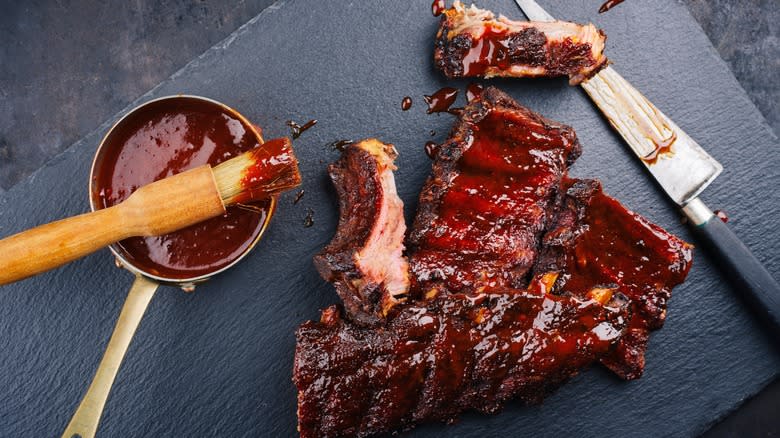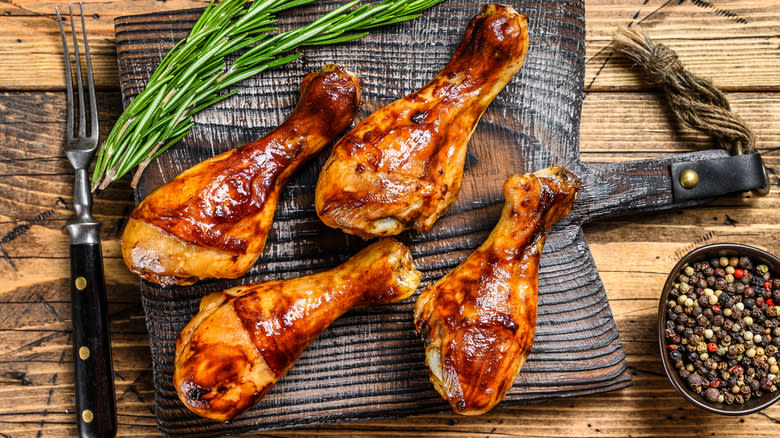Kansas City Vs Memphis Vs Texas-Style Barbecue Sauce: What's The Difference?

For some people, barbecue sauce means only one thing — a reddish brown condiment with a consistency close to ketchup. It's something you can order at a fast food spot for dunking your chicken nuggets or find brushed onto a rack of ribs at your local grill. But to true barbecue aficionados, sauce is a spectrum, and different varieties are identified by their place of origin.
It may be a little daunting trying to learn each nuance and style, but when it comes to understanding what you're ordering, it helps to have a working knowledge of some of the more common types. Three such sauces are tomato-based versions that come from Kansas City, Memphis, and Texas.
The classic Kansas City style is the one you might find most familiar; this classic recipe relies on ketchup and delivers a smoky flavor balanced by tart vinegar and sweetened with molasses or brown sugar. You'll get a little extra kick when you reach for your Texas-style, while Memphis is a "wet sauce," meaning it's a little looser and lighter. While there are elemental similarities between these three styles, you'll find varying uses and strengths for each.
Read more: The 15 Best Store-Bought Barbecue Sauces, Ranked
Uses For The Three Different Barbecue Sauce Styles

Given the popularity of Kansas City sauce, there's a good chance you've already used it in some way, especially on classics like ribs, pulled pork, or baked beans. Its superpower is partly in its balance — with elements of tang, sugar, smoke, spice, and umami — and partly in its consistency. Unlike looser sauces, this one can be used in preparing your barbecue dish, for dunking purposes, or even smearing on a burger. Just be cautious about how much heat you apply when cooking a Kansas City sauce-slathered food, though — the abundance of sugar means it can scorch easily.
There's an acidic twist that makes a barbecue sauce "Memphis style" — and that lies in the high level of vinegar. For that reason, tang is the predominant character (though this is also present in the other two options, it's more intense here). This sauce can be applied as a thin sheen on everything from pulled pork shoulder to chicken and veggies.
Texas-style barbecue is a good bet for making delicious smoked Texas barbecue brisket and burnt ends — those bolder preparations that can stand up to a spicier, more assertive, and less sweet sauce. Some recipes use Worcestershire for added umami, but in other renditions, beef dripping is a part of the formula, which adds unmistakable depth of flavor in the form of smokiness and savory, unctuous fat and loosens the sauce a bit.
Tops For Making Your Own Barbecue Sauce

There are many riffs on recipes for these classic sauces and lots of debate about what belongs in each. There are even subregional styles (think "Central" Texas sauce as its own creation). And while you may opt to hew close to classic, their general frameworks provide a great starting point if you're looking to customize.
You can make decisions about what kind of tomato element you'll use (ketchup or tomato paste, for example). You can experiment with different sweeteners, like molasses, brown sugar, honey, or even maple syrup. On the spice front, Kansas City is typically the most straightforward, with salt, garlic, and onion. In Memphis-style, you may even find warming spices like allspice and cinnamon, whereas Texas might include more smoky elements like paprika, ancho, and cumin.
Other methods for incorporating a smoky character into your barbecue sauce are also up for interpretation, be it by using liquid smoke or relying on the cooking process itself to naturally impart the flavor. Whether you opt to try your hand at creating one of these three tomato-based sauces or rely on the professionals, having a little context is a great way to whet your appetite for all styles of barbecue.
Read the original article on The Daily Meal.


